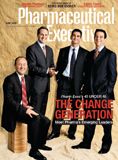The Web Video (R)evolution
Pharma is taking note of online video's power to affect B2B communications
Video has long been considered the most compelling and effective of media. A now-famous 1994 study entitled "Communication: A Key To Human Development" (Fraser and Villet) determined that content in audiovisual format is recalled four to five times better than material that is heard, and nine times better than material that is read.

Matt DeLoca
Today, online video represents the next evolution of this memorable medium. For the viewer, it adds limitless on-demand access from any computer; content can be searched, shared, tagged, and downloaded at will. Audiences can rate, comment, and blog about videos. More importantly, the publisher of the content can track all of this behavior. Web video offers the best of both worlds: the most compelling and effective medium available combined with the interactivity, virility, and metrics that have made the Web such a powerful communications platform.
Web video has rapidly become a powerful venue for large companies to reach their audiences. Thus far, the pharma industry has only scratched the surface of what's possible with online video, mostly with initiatives that have been focused on the consumer. This is not surprising, of course, considering the impact of YouTube—but B2B communication looks to be the next frontier for Web video.
The YouTube Effect
Once a grainy, blurry experience, Web video has become high-def as it has moved into the mainstream. The proliferation of broadband and other improvements in technology have made the online viewing experience high-quality and reliable. According to Comscore, an estimated ten billion online video streams were viewed in February 2008 alone. (This is the total number of streams, not the total number of unique videos. Many popular video clips are watched more than once by the same viewer.) Astonishingly, more than 30 percent of those ten billion were viewed on YouTube. That same month (again according to Comscore) 140 million Americans watched an online video—that's 75 percent of the US Web audience.
This is a tremendous new medium for consumer marketers, and Big Pharmas are beginning to experiment with it. In Novartis' successful FluFlix campaign, consumers were asked to submit their own animated or live-action videos about experiencing the flu. Submissions were uploaded through a specially branded YouTube page, and selected winners were posted on the Novartis-sponsored, flu-education Web site: Flusource.com. This user-generated content-marketing model is growing fast, and taking on many forms.
Targeting the B2B Audience
While all this consumer video creation and consumption has marketers excited, the vast majority of pharmaceutical consumers are not of the YouTube demographic. According to the social networking news Web site mashable.com, the average age of YouTube consumers at 27.
Does this mean Web video is of no use to pharmaceutical companies? Perhaps not for broad-based consumer outreach. But the next phase of growth for Web video is in B2B communications, and pharmas may be able to benefit from that. According to a 2007 Gartner Group Study, 80 percent of all enterprises will eventually use video or rich media as part of their overall corporate communications plans.
Pharmaceutical executives should integrate Web video into their traditional means of communications, such as employee training (especially with salespeople), and reaching physicians (enhancing eDetailing and CME initiatives). Video can also help large healthcare companies communicate better with investors and the media.
Web Video in the Real World
Consider Bristol-Myers Squibb's "Prevailers" campaign, which promoted the brand to a wider audience, from financial analysts to industry journalists. Largely a consumer ad drive distributed on TV, BMS also carried the content online at Prevail.BMS.com, reaching any visitor to the company's Web site. The collection of videos features stories from cancer and AIDS survivors, as well as others who have faced serious debilitating conditions. The stories, told by the patients themselves speaking directly to the camera, express emotion and sincerity. The end goal of these videos is twofold: first, to inspire any viewer, whether he or she is a consumer, an employee, or some other type of influencer; and second, to increase awareness of the impact Bristol Myers-Squibb has on patients' lives. The effect on the viewer is powerful and memorable.
In another example, Bausch & Lomb used Web video in crisis management, after recalling a contact lens solution with possible links to eye fungus. Instead of a generic press release, visitors to the company's home page found a video featuring CEO Ronald Zarrella speaking directly to the issue, detailing the steps being taken by the company, and providing information on where consumers could turn with questions. This approach put a human face on the issue (a face happened to belong to the person with the most control in the situation.) JetBlue airlines took a similar approach after its planes were stuck on runways for many hours in 2007. In both cases, Web video enabled the company's chief executive to express concern and offer solutions with greater emotion, sincerity, and clarity.
Employee and Sales Force Development
For any large corporation, it's a challenge to keep employees up-to-date and engaged in the latest corporate messages. Web video enables an "always-on" network that can reach employees at their desks, on the road, or even in their homes. Private video intranets are beginning to replace cumbersome satellite systems, which can be expensive, and where viewership is difficult to measure. In addition, Web-based video solutions can cost up to 10 times less than satellite, content is available both live and on-demand, and all usage metrics can be tracked. Furthermore, most employees already use the intranet on a regular basis, so adding video is an enhancement they can easily adopt. Web video can also be delivered in multiple languages, all from the same Web page.
Pharmaceutical sales forces are particularly well-suited for Web video; they're young and well-versed in interactive media, and they are in constant need of information from headquarters. With Web video, they can hear directly from management or subject-matter experts in preparation for field calls. Web video solutions also include podcasts and other downloadable formats that can be viewed off-line and even shared with physicians.
The Cutting Edge: What's Next?
Envision a scenario where patients are able to find concise explanations of chronic disease management, such as what to expect when starting a new treatment regimen. This information can be delivered directly by a world class physician—or better yet, by a fellow patient who has gone through the same experience. This would bring new depth to both branded and non-branded drug Web sites.
Looking ahead, Web video will enhance and expand the communication between all constituents in the healthcare product chain. Physicians can hear from their peers and other experts; salespeople can tune in to this conversation and increase their level of expertise; eDetailing can include a personal message from the salesperson, conveying more than any brochure alone could; Web video can be combined with contextual links, each clip offering supporting Web page links, related PDF documents or PowerPoint slides, and other calls to action. It goes way beyond just watching a clip—Web video lets the viewer react and engage. And all of this rich content is searchable, bloggable, and easy to share with others. In the future, video will be the ultimate corporate knowledge base.
Matt DeLoca is senior vice president at The FeedRoom, Inc. He can be reached at mdeloca@feedroom.com

The Misinformation Maze: Navigating Public Health in the Digital Age
March 11th 2025Jennifer Butler, chief commercial officer of Pleio, discusses misinformation's threat to public health, where patients are turning for trustworthy health information, the industry's pivot to peer-to-patient strategies to educate patients, and more.
Navigating Distrust: Pharma in the Age of Social Media
February 18th 2025Ian Baer, Founder and CEO of Sooth, discusses how the growing distrust in social media will impact industry marketing strategies and the relationships between pharmaceutical companies and the patients they aim to serve. He also explains dark social, how to combat misinformation, closing the trust gap, and more.